
A single Bitcoin in 2010 cost less than one cent. Now, one Bitcoin is valued at about $3,500.
You probably already know about Bitcoin, and that massive jump in value is likely why.
But what about Ethereum which has nearly $30 billion worth of coins in circulation? Or emerging coins like Ripple or Litecoin? Joke currencies like Dogecoin or FedoraCoin? The deeper you dig into the blossoming world of cryptocurrencies the weirder it seems to get.
Don’t let the memes fool you, though. Cryptocurrencies are establishing themselves as the real deal. Their use values are appearing and their massive levels of inflation have already made some people a lot of money!
Given the seeming technological complexities of cryptocurrency, many young people are the forming the public body of participants who are bringing these new currencies into the mainstream. As the New York Times put it:
“Grandpa had a pension. This generation has cryptocurrency.”
In this article, the third of our Process Street Future Finance series after Micro-Investing and Equity Crowdfunding, we’ll look at 3 key areas to equip you with the knowledge to jump on the cryptocurrency bandwagon before it’s too late:
- What is cryptocurrency and how does it work?
- What currencies are available and how do they differ?
- What are the steps to getting started with cryptocurrencies?
What is cryptocurrency and how does it work?
The libertarian ethic and the spirit of cryptocurrency
 Let’s first off start by saying that cryptocurrencies aren’t actually brand new anymore. Bitcoin was the first decentralized cryptocurrency in 2009. That’s already nearly a decade old and the technology and theories regarding cryptocurrency predate that even further.
Let’s first off start by saying that cryptocurrencies aren’t actually brand new anymore. Bitcoin was the first decentralized cryptocurrency in 2009. That’s already nearly a decade old and the technology and theories regarding cryptocurrency predate that even further.
The first descriptions of what we now consider cryptocurrency were published in 1998 by Wei Dai in his article b-money. The first paragraph of this article sheds light on how the public perception of cryptocurrencies has come to be viewed as a community of what the New York Time refers to as:
“…technologically sophisticated anarchists and libertarians excited about a decentralized financial network not under government control…”
Dai’s first paragraph reads:
“I am fascinated by Tim May’s crypto-anarchy. Unlike the communities traditionally associated with the word “anarchy”, in a crypto-anarchy the government is not temporarily destroyed but permanently forbidden and permanently unnecessary. It’s a community where the threat of violence is impotent because violence is impossible, and violence is impossible because its participants cannot be linked to their true names or physical locations.”
What we see from the beginning is a radical technology. One which is theorized as a tool to allow for the systematic overhaul of society. The challenge written into the heart of the technology is that of the destruction of the state’s monopoly on violence; a conceptual framework founded in the work of Bodin and Hobbes with hundreds of years of scholarship and debate built on top of it.
The German sociologist Max Weber, when defining the modern nation state, relies upon this monopoly as his core thesis. In Politics as a Vocation (1919), he writes:
“[the state is the] …only human Gemeinschaft [community] which lays claim to the monopoly on the legitimated use of physical force. However, this monopoly is limited to a certain geographical area, and in fact this limitation to a particular area is one of the things that defines a state.”
All of this is a long winded way to make use of my philosophy degree say that cryptocurrency’s revolutionary beginnings demonstrate their disruptive and transformative potential, whether or not you agree or consider the initial political aspirations. Even if cryptocurrencies do not revolutionize society’s relationship with the nation state, they look increasingly likely to revolutionize elements of financial markets, at the very least.
The first currencies and how they were constructed
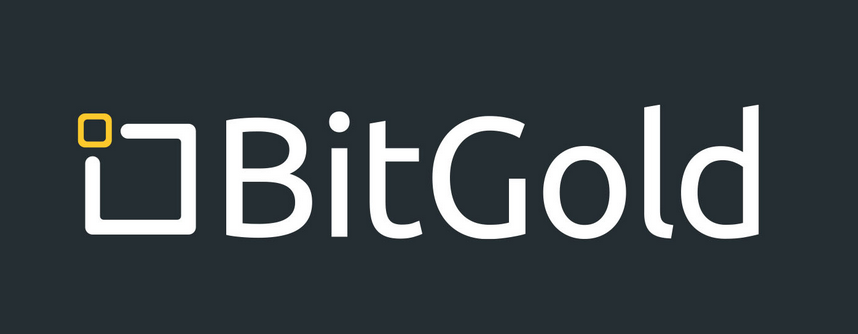 One of the first incarnations of cryptocurrency was BitGold, created by Nick Szabo. This was a kind of precursor to Bitcoin and you can find Szabo’s writings about that in in his blog post Unenumerated – written at the time, in 2008. More recently, Szabo was featured on Tim Ferriss’ podcast about cryptocurrency, where he delves further into the future potential of cryptocurrencies.
One of the first incarnations of cryptocurrency was BitGold, created by Nick Szabo. This was a kind of precursor to Bitcoin and you can find Szabo’s writings about that in in his blog post Unenumerated – written at the time, in 2008. More recently, Szabo was featured on Tim Ferriss’ podcast about cryptocurrency, where he delves further into the future potential of cryptocurrencies.
Bitcoin was the first real cryptocurrency which took off. Bitcoin works on the basis of a few fundamental building blocks. Before looking into other cryptocurrencies and how they differ slightly in their approach, let’s cover the basics.
Bitcoin is based on a system of peer to peer transactions secured by cryptography. Think of the films you definitely don’t torrent, and that gives you a rough conceptual framework. It’s architect was Satoshi Nakamoto, who is an interesting figure in his own right with one Australian entrepreneur Craig Wright claiming that he is the real Nakamoto – though, that appears to be unlikely. Not that any of this matters to the Bitcoin community. As Bitcoin entrepreneur Andreas Antonopoulos phrased it:
Identity and authority are distractions from a system of mathematical proof that does not require trust. This is not a telenovela. Bitcoin is a neutral framework of trust that can bring financial empowerment to billions of people. It works because it doesn’t depend on any authority. Not even Satoshi’s
Bitcoin relies on people mining the coins. Basically, the computing power of your PC is put to work solving complex problems. In return for solving these problems, you receive/create new Bitcoins. There is a cap on the number of Bitcoins which can come into existence set at 21 million and a schedule for determining their release up until 2040. Given the increased interest in mining Bitcoins along with the cap and scheduling factors, it has become more difficult over time to generate revenues from mining – particularly for the casual participant.
Due to the increasing popularity of Bitcoin and its shift into the mainstream, many people who wish to enter into the market use Bitcoin exchanges. This works much like any other currency exchange and allows you to invest into Bitcoin in a similar sense to treating a currency as a commodity.
Bitcoins are stored in your electronic wallet. The advantage of this wallet compared to the one you keep in your pocket is not just that it is a secure storage space, but also because each coin in your wallet is identified as belonging to you within the decentralized Bitcoin ecosystem. Though, Bitcoins have been stolen from wallets in the past, the incentive to do so is low given how difficult they would be to spend as they’re identified against their legal owner.
This whole security element described above is premised on something called the blockchain. While Bitcoin is a very private and anonymous currency, it is also inherently transparent. This transparency is facilitated by the blockchain which is a constantly updated public record of all transactions. If you imagine each of these transactions as a statement, “I, Adam_1, pay you, Reader_1, 2 Bitcoins for your positive comment”, then that statement is saved as a transaction on the blockchain. I can’t pretend I didn’t say it. The transparency of the statements – or contracts – keep it secure. Moreover, how embedded that statement is within the other statements around it makes it increasingly secure as the blockchain grows.
The purpose of Bitcoin in this sense, is that you don’t need to trust a bank or some other third party – what Szabo calls a “wet space” – to verify interactions. The whole process is done natively within the computer code using the decentralized network to provide the checks and balances.
One of the next spaces cryptocurrencies are heading into is the legal zone – an extension of the statement in each transaction to being a more complex contract. Contracts built into the currency itself. But we’ll come to this as we look at the different currencies we have available to us.
What currencies are available and how do they differ?
Bitcoin
 If you knew anything about cryptocurrencies before you clicked on this article then you were probably already familiar with Bitcoin. The O.G. of the cryptocurrency world, Bitcoin has made a lot of money for a lot of people. The success of Bitcoin is arguably the driver behind every other cryptocurrency.
If you knew anything about cryptocurrencies before you clicked on this article then you were probably already familiar with Bitcoin. The O.G. of the cryptocurrency world, Bitcoin has made a lot of money for a lot of people. The success of Bitcoin is arguably the driver behind every other cryptocurrency.
If you want an idea of how much money some people have made with Bitcoin, check out this calculator which lets you enter an initial investment amount and a date to calculate what the current value of that investment would be now.
One Bitcoin success story is Erik Finman, an 18 year old from Idaho, who invested $1,000 into Bitcoin in May 2011 when he was just 12 years old. He made a bet with his parents that he would become a millionaire before he was 18 so they wouldn’t make him go to college. You guessed it, he now owns $1.09m in Bitcoin. It’s a nice soft news story which has closed segments on tv and earned Erik an AMA on Reddit.
Leaving aside the fact that at 18 the decision of whether to go to college or not would have been Erik’s anyway, the massive riches he earned through Bitcoin were seemingly not down to clever trading. In fact, according to the calculator of ours mentioned previously, $1000 invested in May 2011 would generate a profit of $1,119,965. That’s over 100k more than Erik has.
 I don’t mean to talk Erik down. He’s a young lad and he has much more money than I do. Plus, he’s expanded his experience to tech startups and a whole range of really exciting little projects including sending a time capsule into space. You go, Finman!
I don’t mean to talk Erik down. He’s a young lad and he has much more money than I do. Plus, he’s expanded his experience to tech startups and a whole range of really exciting little projects including sending a time capsule into space. You go, Finman!
That said, if you’re looking to make long term money on Bitcoin then it’s not clear whether playing the field will earn you any more money than simply buying low and selling in the far future. Though, at least it keeps you in the loop in regards to your investments…
There are risks and worries to be had with any cryptocurrency and many of them can be seen or understood through Bitcoin. Which brings us on to security and related concerns.
One of the effective elements of Bitcoin in providing security is that the blockchain, or the ledger, can’t be reworked or rewritten retroactively because of the decentralized nature of the technology. Nick Szabo describes the risk factor which has been called by some the 51% rule. This is the idea that if 51% of all the computers running “nodes” – recording the blockchain – were to collude or be owned by the same person, then they could begin to wreak havoc with occurring transactions. They still wouldn’t be able to play with old information, but they could do damage in the present.
Why someone would want to do that is a whole other question. To do so would likely destroy Bitcoin as a currency, and to be in the position to do that probably means you’ve got a hell of a lot to lose. So I wouldn’t worry too much about it right now.
Where problems have occurred is within the exchanges. Some purists aren’t fans of exchanges to begin with, as they see certain platforms attempting to operate as banks within this libertarian ideal where the banks have been figuratively burned. Misgivings have been heightened come each scandal. The most notorious might be the Mt.Gox fiasco where half a billion dollars worth of Bitcoin went missing.
Mt.Gox filed for bankruptcy in 2014 after losing $450m in Bitcoin and a further $27m in cash. The company started as a space for trading playing cards; its name deriving from Magic The Gathering Online eXchange. With the rise in Bitcoins the focus shifted from the DnD-esque game to trading in currency. The details of how all these Bitcoins went missing are sketchy, but it is understood that near to $300m are still missing.
Ultimately, cryptocurrencies are not a very tightly regulated industry and an increasingly large presence of third party exchanges which aren’t held to high levels of security could always hold the potential for risk. It’s worth bearing in mind.
Ethereum
 Previously in this article, we’ve loosely mentioned how statements within transactions act as a kind of contract. This theoretical position becomes quite an important one when we look at Ethereum and how it differentiates itself from Bitcoin.
Previously in this article, we’ve loosely mentioned how statements within transactions act as a kind of contract. This theoretical position becomes quite an important one when we look at Ethereum and how it differentiates itself from Bitcoin.
Ethereum, to an extent, is a cryptocurrency like the others and works on the same rough principles and structures. However, from an investment perspective, Ethereum encourages the use of these contracts in more creative ways. This gives us more of a focus on something called Smart Contracts.
In their podcast, Tim Ferriss, Naval Ravikant, and Nick Szabo discuss abstractly what money is and how we conceive of it. One point they make is to emphasise the centrality of information flows. Money, law, code, math; it is all ultimately information. Consider it an atomistic approach to money.
The idea is that all of those factors can be contained in each transaction. In their example, they imagine two people doing a business deal across geographical, language, and currency barriers. A well constructed transaction can communicate all the necessary information and tie it to the security of the broader network. The statement on the transaction acts as a contract and removes the need for third party services.
For our investing purposes, all this is important. Yet, Ethereum is much more than this. Ethereum is a kind of software platform which allows developers to build decentralized applications on the same blockchain structures which maintain the internal currency, Ether.
This image below, from a great article by Blockgeeks, demonstrates how a smart contract works in practice. The contract functions like a mini program and the code in the contract releases Ether automatically as certain conditions are met.
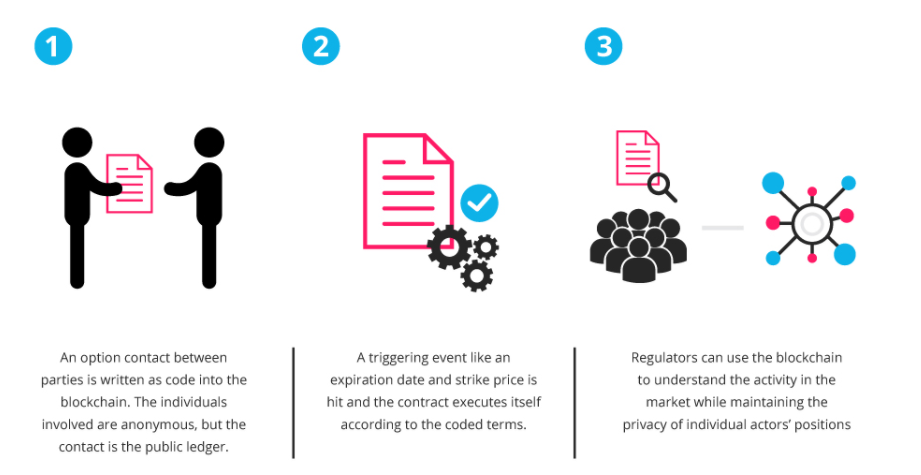
Ethereum’s focus on giving developers the ability to write increasingly complex applications expands the potential of the blockchain beyond what Bitcoin offers.
This is useful for us, as people who want to invest, as it starts to show clear use-value in the currency beyond what normal currencies are capable of. Bitcoin gives you anonymity but Ethereum rethinks how we interact with currency from first premises.
If you want to investigate getting started with Ethereum, it’s a good idea to check out their site and see what use cases you would get involved in. You can build applications through the platform, invest in Ether, create your own cryptocurrency easily, or look to kickstart a company through their crowdsale system.
One company started on Ethereum is Matchpool which looks to connect people by starting ‘pools’ and inviting others into them. Through making connections you can earn Gups, which act as their internal cryptocurrency. This incentivizes people to meet up, making the core concept of the application more effective.
If you were to invest in Matchpool within Ethereum through a token sale, you would gain voting rights and be able to invest not just in the value of the Ether you’ve bought, but in the company as well. Definitely worth checking out!
For general Ethereum investing, you can also check out this crowdfunding company built on Ethereum called Weifund. We’re talking about very early stage stuff here, so don’t be too harsh. Weifund are even offering Ether to anyone who finds bugs in their site. Even more incentive to check them out!
You can read more about this changing structure in Naval Ravikant‘s article The Bitcoin Model for Crowdfunding. In it he discusses how the smart contract is less like a new form of transaction and more like a new business model, providing the potential to change how businesses operate on a fundamental level.
Other crypto-options to consider
Litecoin
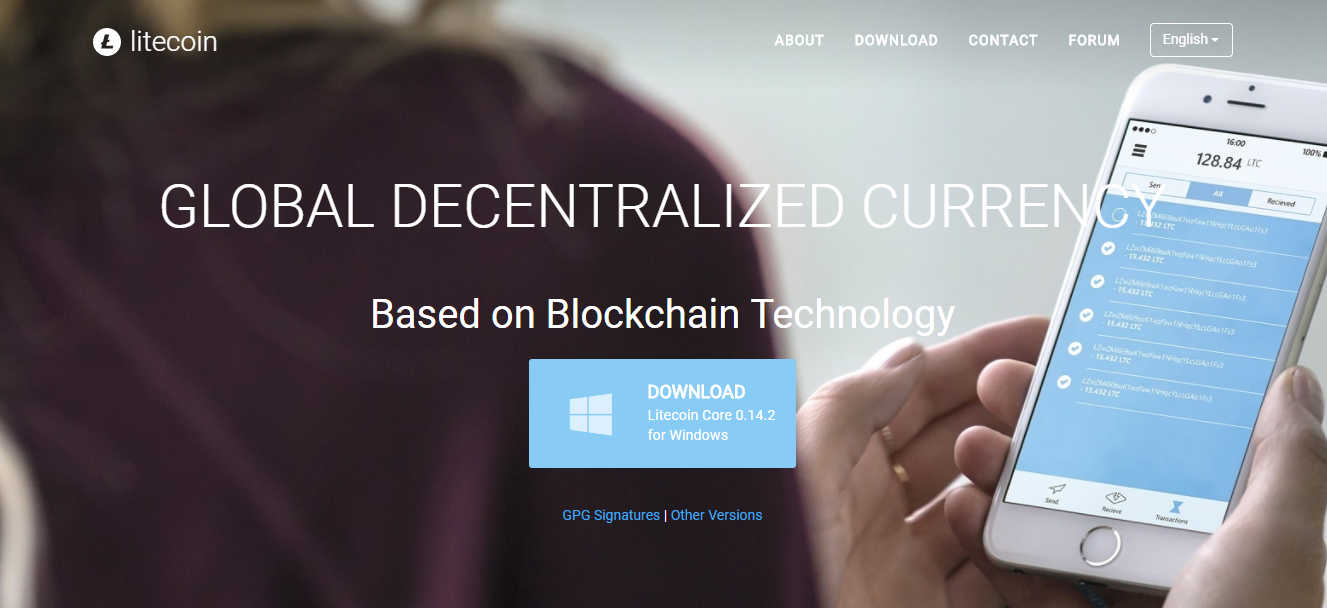 Litecoin was started by Charles Lee in 2011 with a view to being the silver to Bitcoin’s gold. It currently has a market cap of around 2.5 billion dollars to Bitcoin’s 55 billion. A single coin right now will cost you just under $50.
Litecoin was started by Charles Lee in 2011 with a view to being the silver to Bitcoin’s gold. It currently has a market cap of around 2.5 billion dollars to Bitcoin’s 55 billion. A single coin right now will cost you just under $50.
Though Litecoin started strong, it doesn’t seem to have kept up with Bitcoin and other currencies have also been performing well against it.
Ripple
 Ripple has garnered media attention over this past year as its own currency Ripple XRP has increased in value x40. Only 5 years old, Ripple is sitting on billions of dollars after a recent surge in popularity. The goal of Ripple was to create a real time payment platform for sending money all over the world.
Ripple has garnered media attention over this past year as its own currency Ripple XRP has increased in value x40. Only 5 years old, Ripple is sitting on billions of dollars after a recent surge in popularity. The goal of Ripple was to create a real time payment platform for sending money all over the world.
Seemingly, consumers liked its interface and had faith in XRP’s value appreciating, which created the perfect position for Ripple to shoot up from. Unlike some of the other coins, XRP can be bought for way less than a dollar as there are already 100 billion floating around. Ripple appears to be one to keep an eye on.
Dash
 Another popular currency right now is Dash, formerly known as Darkcoin and XCoin. Dash is like Bitcoin structurally and also performs instant transactions like Ripple. It offers further services like private transactions and decentralized governance, so it’s building on the blockchain movements of others within the ecosystem.
Another popular currency right now is Dash, formerly known as Darkcoin and XCoin. Dash is like Bitcoin structurally and also performs instant transactions like Ripple. It offers further services like private transactions and decentralized governance, so it’s building on the blockchain movements of others within the ecosystem.
A single coin will cost you just over $200 right now. You can find more about Dash and hundreds of other coins’ performance at CoinMarketCap.
What are the steps to getting started with cryptocurrencies?
Firstly, let’s be clear: I am not a financial advisor and you shouldn’t act on any of the information in this article without consulting a professional.
Now that’s out of the way, I’m going to buy some different cryptocurrencies and walk you through my journey. This way, you have an actionable guide to getting started. We’ll start with a wildcard and finish with a simple way to buy Bitcoin.
Gambling on a new coin
I’m going to go very niche with my choice of coin. This is partly to keep the article interesting, and partly because the higher risk has the potential for higher reward.
I’m going to buy one coin of OneGram. This is a fairly new cryptocurrency which is currently having its ICO.
An ICO is an Initial Coin Offering where you can buy the coin before it goes fully out into the wild. It’s much like an IPO on the stock market. Essentially, buying during an ICO means you’re taking that early risk to help them get started and you’ll get to buy in for a lower amount as a result.
I chose OneGram because the concept is interesting. It claims to be the first cryptocurrency which adheres to Islamic law. It seems to work by backing its currency with gold and buying more gold as the currency grows. This feels a lot like a regular currency, which makes me a little uncertain whether it will be worth the risk.
On the downside, the stability offered by being connected to gold could drive down my returns. On the upside, there are lots of muslims in the world who might want to get involved with this over the next few years; it has a USP.
For anyone who wants to know more about this coin, you can read the whitepaper. It gives a nice breakdown of the concept, growth, and a bit of theology – because why not? After the ICO, no new coins will be created and that’s when the price of the coin should grow above and beyond the price of gold, apparently.
I’m not suggesting this is a wise investment. But it should cost me about $50, so I’m not too fussed.
Let’s see how it goes.
Here’s my info screen letting me know how much it currently costs and how the sale is going so far:
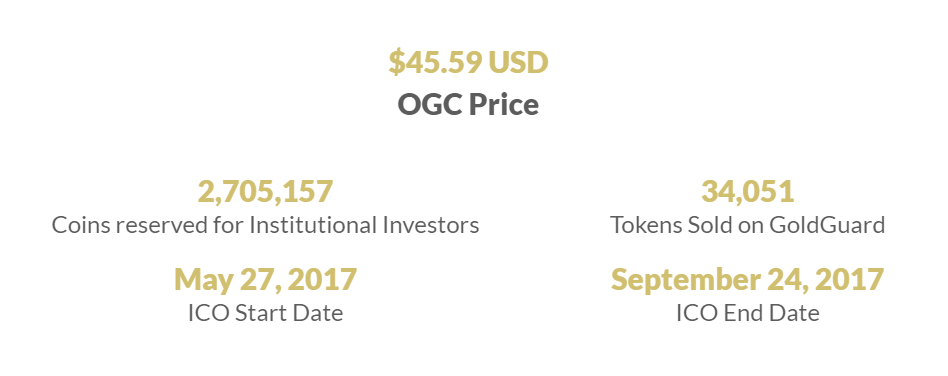
It has sent me to a site called GoldGuard where I have to buy gold and exchange said gold through the same platform for my OneGram Coin (OGC). This is not a normal way of purchasing cryptocurrency…
I may have picked a bad example for this article.

I’ve now created a personal account and confirmed my email address. Apparently, I need to verify my account at some point, but for the time being I’m going to go ahead and try to buy 1 halal coin.
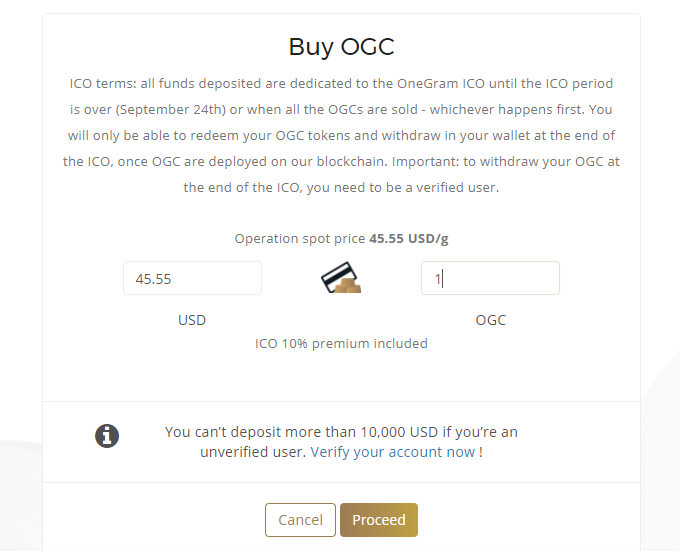
I’m not going to screenshot my payment screens as you don’t need to see that info. I was given the option of a bank transfer or pay with Bitcoin. The system then automatically allocates you your OneGram coin to what appears to be the nearest 9th decimal place.
This wasn’t really indicative of buying regular cryptocurrency through an ICO, but it does provide an interesting use case to show the expanding world of cryptocurrencies.
Safety first: an easy way to buy Bitcoin
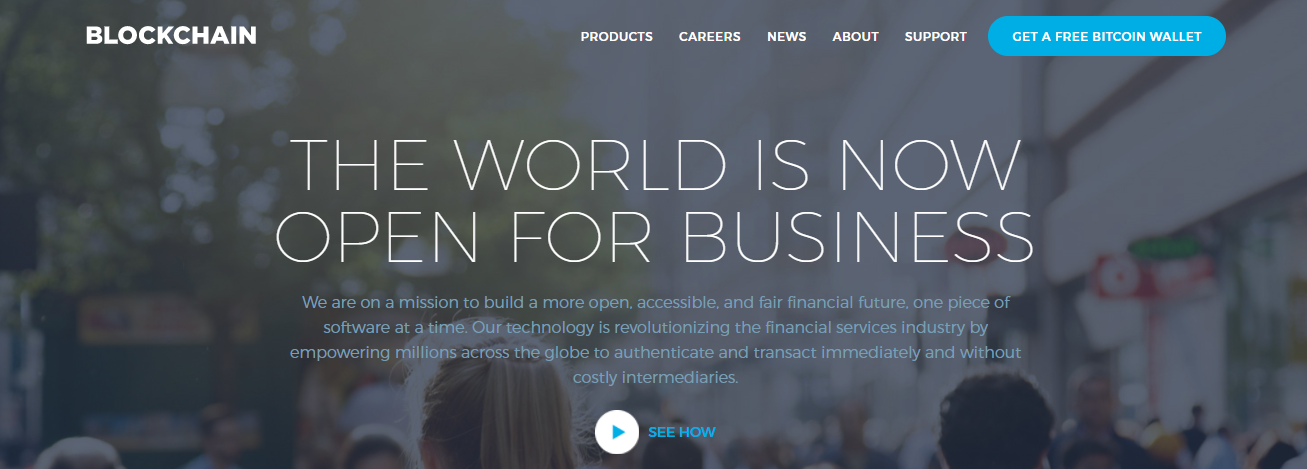 There are lots of ways to go about buying Bitcoin. I’ll mention one of the easier routes which also makes it convenient to make use of your Bitcoin once you have it.
There are lots of ways to go about buying Bitcoin. I’ll mention one of the easier routes which also makes it convenient to make use of your Bitcoin once you have it.
You’ve possibly heard of lots of technical ways to get Bitcoin, or been confused by how you’re meant to store it in your Bitcoin wallet. It can actually be very simple.
You can find a mobile app called Blockchain (other options are available) on iOS and Android.
When you download the app it will give you the chance to create a new wallet. Go ahead and do that. The process is super simple and you can set a pin or fingerprint entry to the app to make it secure. If you try to log in online it will ask for your wallet ID and password, then ask you to confirm the login attempt from your email. There are multiple levels of security built in, so you should be in safe hands.
Once you have your wallet, you can buy Bitcoin from within the app or from other places using the information of your wallet. You can use the app to manage your Bitcoin transactions, both sending and receiving Bitcoin.
That was simpler than you expected, wasn’t it?
Note: I advise anyone reading to take their investments more seriously than my foray into gold bullion, sharia compliant or otherwise.
Investing in cryptocurrency provides a lot of potential
You don’t always have to go for niche ICOs to look to make a good amount of money.
One ICO happening at the moment is for a much hyped currency, Filecoin. This coin has already raised $52m from advisers and has just opened its ICO to accredited investors.
Filecoin wants to use its blockchain technology to create a distributed file storage system, not just a currency. Its current investors include Sequoia Capital, Andreessen Horowitz, and Union Square Ventures.
If investors like these want to take a punt on it, you can be sure there’s something to it.
The range of investment opportunities available is near endless. You can play it safe with Bitcoin, crowdfund with Weifund, buy into new businesses with Ethereum, or explore any one of the huge number of emerging currencies and blockchain businesses available.
Digital technologies move quickly. Jump in.
Have you invested into cryptocurrencies? Have you built something through Ethereum? Let us know your experiences with the blockchain in the comments below and we may reach out to you for more!







 Workflows
Workflows Forms
Forms Data Sets
Data Sets Pages
Pages Process AI
Process AI Automations
Automations Analytics
Analytics Apps
Apps Integrations
Integrations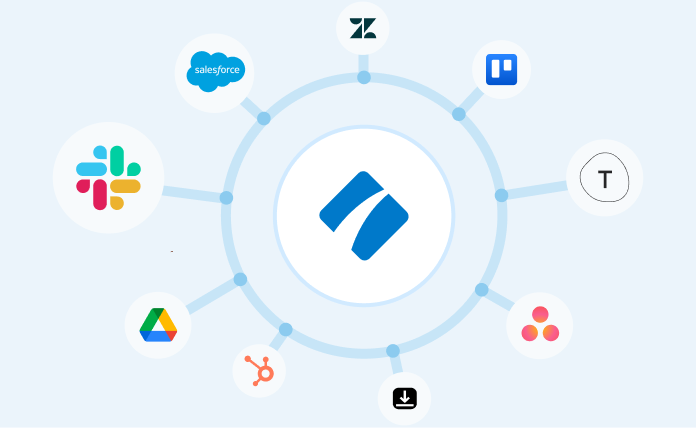
 Property management
Property management
 Human resources
Human resources
 Customer management
Customer management
 Information technology
Information technology



Adam Henshall
I manage the content for Process Street and dabble in other projects inc language exchange app Idyoma on the side. Living in Sevilla in the south of Spain, my current hobby is learning Spanish! @adam_h_h on Twitter. Subscribe to my email newsletter here on Substack: Trust The Process. Or come join the conversation on Reddit at r/ProcessManagement.